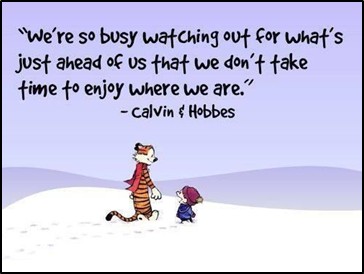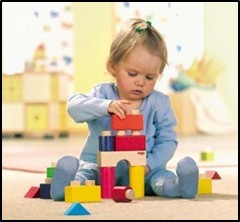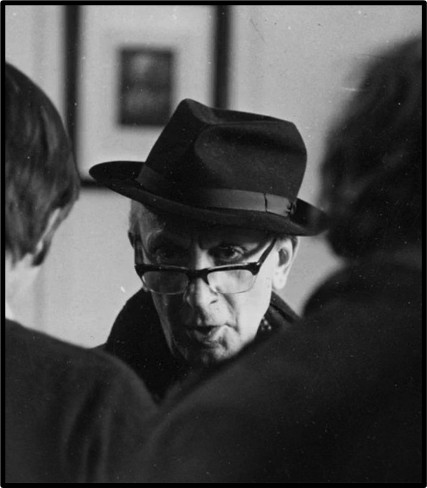THE IMPORTANCE AND VALUE OF ‘BEING’ - PATRICK TOMLINSON (2014, REVISED 2025)
Date added: 16/10/24
Download a Free PDF of this Article

(Bill Watterson)
For many of us, this time of year (holiday season) is a time for ‘being’ with each other and a temporary stop in our often frenetic lives of doing. It can be a special time of being with those to whom we are closely bonded by family and friendship. However, as this potential opportunity is often at odds with our regular day-to-day life and work experience, we might just replace one kind of doing or activity with another, such as excessive consumption. While our lives may be busier the problem is not new. In 1934 Marion Milner (2011, p.63) captured the struggle well,
I want to change my attitudes; it fills me with restlessness that I am always striving after something and I don’t know what it is. I envy people, artists chiefly. I want to achieve the play attitude. By this, I mean concentration in an activity which has no apparent use just for the delight of doing it.
The advent of a new year can be a time of reflection, which again can also be obliterated by hyperactivity under the name of celebration. It seems an appropriate time to write a blog about the value of being, as opposed to doing. The capacity to reflect is hugely beneficial to our health, especially when it is built into daily life. Bessel van der Kolk (2014, pp.239-241) has referred to numerous research studies that show that the regular habit of reflective writing can improve the speed of recovery from some illnesses and injuries. Reflection can reduce stress, which improves the immune system, etc.
Increasingly, we hear about the value of reflection, and concepts such as mindfulness are becoming familiar. The principles involved are not new and can be traced back thousands of years and are embraced in many fields, such as Buddhism. In terms of child development and healthy adult capacities, the ability to reflect, think about oneself, and consider what others might be thinking about oneself is an essential part of being able to relate to others. Some researchers have argued that the ability to reflect on one’s experiences is a greater indicator of health than how much adversity one has experienced. As Kezelman and Stavropoulos (2012) have created excellent guidelines for trauma-informed services, state,
It isn’t just what happened to you that determines your future – it’s how you’ve come to make sense of your life that matters most.
Digesting and making sense of experience requires a degree of allowing ourselves to be, to ‘sit with’, and to feel. Whereas, busily doing can be a distraction and a way of avoiding feelings and thinking. As a result, the avoided feelings and experiences associated with them remain unprocessed and therefore unintegrated into our personality. The feelings are inaccessible as any kind of a useful guide or resource for the future. Learning from experience comes to a halt and therefore so does development.
Interestingly, I started a discussion on this subject on my LinkedIn group in January two years ago. I wonder whether the timing of the New Year is coincidental. The quality of the discussion was excellent, and I think partly because the theme is so universal and not just relevant to our work with traumatized children. Some of the comments made by members of the group show how much this subject resonated with them,
Imagine that, listening to understand rather than to just respond (teach/tell/direct) - incredible! (Ian Nussey - Australia)
... my role was just to be there listening. (Lorna Miles - UK)
Ian responded – The special ingredient Lorna - genuinely being with ...
The opportunity for free play, space, and being with each other and adults was hugely important. (Judy Furnival - Scotland)
… being new to therapeutic care in a residential environment my strategies are at times very basic in the way that I go in and just be me in a relaxed manner as opposed to some that just need to be completely planned throughout each minute of the day, which in my opinion leaves no time for proper self-reflection. (Aaron Hamill - Australia)
In today's society, every minute of every hour is organized, which leaves very little time for children to be creative. ……. Always organizing their free time is not the best thing for helping children develop creativity, self-regulation, and imagination. (Sylvie Demers - Canada)
I agree that children need time to be rather than do. The problem, as I see it, is that some children don't know how to be except within a trauma framework. Their frenetic activity might be a way of avoiding thinking and being. (Christine Gordon - Scotland)
-------------------------------------
With a group of young people I worked with, we used to plan our evening activities in a meeting after tea. The usual things offered would be soccer, cricket, bike rides, walks, card games, crafts, swimming, etc.
One evening I decided to offer that I would spend a half-hour or so ‘being’ in the living room and those who were interested could ‘be’ with me. Naturally, this aroused curiosity as to what ‘being’ involved. I explained something like, just being together, chatting, playing if people wanted to, maybe listening to music, etc. It was less structured than usual, though still with some boundaries. After a while, ‘being’ became a popular thing to do – if that is not a contradiction! A general feeling of safety is necessary for this kind of possibility to develop. I enjoyed these times and over the years have found that girls are better at this than boys – though I might be generalizing too much from my own experience.
Being rather than doing can be difficult as it allows time to think and feel. For people who are traumatized, thinking and feeling is often frightening. Thoughts and feelings must be kept at bay and one way of doing this is through frenetic activity as Christine described above. The world of these children can become a desolate place without emotion. Being rather than doing, conjures up possibilities. There is a sense of uncertainty and not knowing, a lack of control. To a healthy person, this might be challenging but also potentially exciting - to a traumatized person it might be terrifying. Anyone close to a traumatized person is likely to pick up this fear and coupled with their own, can easily be swept into a whirlwind of activity as a form of avoidance. In the world of ‘therapy’, especially psychoanalysis, it is often stated how important it is for the therapist to tolerate a sense of 'not knowing'.
 The concept of Negative Capability coined by the poet John Keats back in 1817 is often referred to. Keats described negative capability as the art of remaining in doubt “without any irritable reaching after fact and reason” and “the willingness to embrace uncertainty, live with mystery, and make peace with ambiguity”.
The concept of Negative Capability coined by the poet John Keats back in 1817 is often referred to. Keats described negative capability as the art of remaining in doubt “without any irritable reaching after fact and reason” and “the willingness to embrace uncertainty, live with mystery, and make peace with ambiguity”.
The British psychoanalyst Wilfred Bion elaborated on this, describing negative capability as the ability to put aside preconceptions and certainties and tolerate the pain and confusion of not knowing. More recently the child psychotherapist and psychoanalyst Adam Phillips in discussing parenting has said,
"... that the parents, the authorities, are at their most dangerous when they believe too militantly that they know what they are doing."
Why is this subject of ‘being’, which allows the space for something unknown to unfold, so important? I think the key reason is that it is central to the process of our development, as individuals, groups, and societies. How we can be with ourselves individually and collectively is fundamental to our health. Patty de Llosa (2017) reminds us,
We’re all members of a species called human beings, not human “doings.”
An infant is born into the world with a distinct lack of ability to be with and tolerate different emotional states. Anything that causes distress requires someone else to be with them and to emotionally contain the distress. As Donald Winnicott (1960, p.586) said,
There is no such thing as an infant, meaning, of course, that whenever one finds an infant one finds maternal care, and without maternal care there would be no infant.
The critical issue is what that other person does with the difficulties involved. Is she/he able to tolerate the feelings involved and to think about the infant, or does he/she also find the distress intolerable and feel the need to only take it away? The difference for the infant may be between,
- a helpful/thoughtful response
- a relieving/thoughtless response
- an unrelieving/thoughtless response
The first changes the infant’s experience in a way that might encourage him to develop his capacity to think about his feelings and hence find thoughtful solutions to difficulties. The second might relieve the infant of his distressing feelings, but in a way that discourages thinking and encourages dependency on a quick fix. This is about taking away the distress rather than developing the capacity to sit with it and find constructive solutions. The third just makes matters worse for the infant and is likely to lead to the need for defensive protective measures, such as switching off from emotions.
Bearing Pain
An important question is whether distress or ‘psychic pain’ is perceived as something to be rid of and/or relieved, or whether it is something primarily to be understood in a way that makes it tolerable. This is the difference between parents, who are motivated by the desire to relieve their children of pain, and those more on the side of helping their child learn to manage painful experiences. The same applies in other aspects of life, such as the workplace in general, and the helping professions. Do we want to rescue another from pain and difficulty, or be alongside them as they find their way? These dynamics are well known in our profession in the form of victim/perpetrator/rescuer. The media also portrays Images of leaders as heroic figures coming to the rescue, with the answers to fix a problem rather than as people who work alongside others to find solutions (Ward, 2014). We can all wish for a ‘magic wand’. Sometimes a solution might not be possible, and it is more about finding the best way to live with the ‘problem’.
There may also be a cultural tendency to view all depressive feelings as a problem to be got rid of or solved. One child who had suffered many difficulties and losses that he needed to feel sad about, said to me,
I need cheering down, not cheering up.
Facing real and painful issues rather than avoiding them is how experience can be integrated into our identities in a way that furthers our learning, understanding, and development. Difficulty in being able to tolerate any pain or frustration is likely to hinder development.
Whether we are working directly with a child, or in a management/leadership role, resisting the temptation to become the problem solver can be difficult. Our need to get out of the difficulty and to relieve our anxiety can be the primary motivating factor, rather than the development of the person(s) we are with. Generally, working something out oneself with the support of another is a more useful outcome than another working it out for you. It is hard to be alongside someone who is struggling, needing time, and making mistakes. The external environment where others may hold us responsible for the outcome can add another layer of anxiety. It might feel too risky to allow a mistake to happen, so the possibility is pre-empted.
The child and adolescent psychotherapist Margot Waddell (1985) referred to the different ways of responding to human difficulties as one between ‘serving’ and ‘servicing’,
The difference between the two modes might be made by the mother who serves, by being available by 'thinking' emotionally, as opposed to the mother who services by doing instead of thinking.
Waddell elaborates that, “servicing nearly always implies action, with very particular overtones” whereas serving “may constitute not doing anything”. However, as she explains, “not doing anything does not constitute doing nothing”, and “There is a 'world' of difference between 'standing by' and 'being a bystander'”.
 It can be misguided to consider doing as active and not doing as passive. Often it is not doing that is the harder and most useful option. For example, how long can we or should we tolerate watching and encouraging a child who is struggling to do something? How much satisfaction does the child get when he or she achieves the task and thinks, ‘I did that myself!’?
It can be misguided to consider doing as active and not doing as passive. Often it is not doing that is the harder and most useful option. For example, how long can we or should we tolerate watching and encouraging a child who is struggling to do something? How much satisfaction does the child get when he or she achieves the task and thinks, ‘I did that myself!’?
Waddell explains how these same dynamics can be transferred to organizations and societies. Where on a collective scale becoming ‘mindlessly busy’ is a way of avoiding the real difficulties we are faced with. Sadly, this also deprives us of the opportunity to understand those difficulties in a way that leads to growth. This tendency has been clearly outlined by social scientists, going back to the 1950s, such as Elliot Jaques and Isabel Menzies Lyth (1979). They explained how organizations unconsciously develop defensive systems to protect themselves against the emotional pain involved in the task. For example, as Menzies Lyth (1959, 1961, and 1970) so powerfully described the task of caring for patients in hospitals includes primitive anxieties related to the themes of illness, loss, and death. One way of responding to these anxieties is to avoid them by depersonalizing the patient and creating systems that don’t allow ‘professionals’ to get emotionally close to him or her.
We may be familiar with the scene of a doctor talking to his students about the patient in front of him, who is referred to as a number, or the medical problem! While this might help reduce emotional pain (for the Doctor and students), unfortunately, it does not aid the patient’s recovery. The emotional connection between doctor and patient has even been shown to improve recovery from the common cold (Rakel et al., 2009). Therefore, a helpful solution enables the connection between the Doctor/Nurse and patient. However, an approach that recognizes the pain involved also needs to provide appropriate professional support.
Bryony Shannon (2025) in her excellent article, Doing and Being, writes about the emphasis on doing rather than being dominates professional language and practice,
As ever, when we pay attention to our language, we expose so much about the reality of our practice.
- Doing to.
- Doing for.
- Delivering care.
Our use of the term ‘doing’ reflects the transactional nature of ‘care’ work – and of social work too.
- ‘Doing an assessment.’
- ‘Doing reviews.’
- ‘Doing safeguarding.’
It exposes an absence of connection and conversation in our approach. Reveals how the completion of tasks and procedures and forms has become the work. How we prize doing things right over doing the right thing. How what can be counted often appears to be all that counts.
There’s no KPI for being with. No measure for being alongside. No time for being curious. No space for being human.
Presence and Being
Rather than focus on the kind of response we might offer, Friedman (1991, 1999) talked about the importance of providing a non-anxious, calming, self-regulated, and connected presence. He argued that this was the central task of leaders, from families to presidents, and therapists. He claimed this type of presence of the leader, parent, consultant, or therapist is more important than any technique that might be used.
From this perspective, a focus on technique or method, might just be a symptom of anxiety and get in the way. As with Winnicott’s (1972) facilitating environment, and Waddell’s serving this type of presence enables an improved level of functioning and development. Things start working better, whether that is the development of a child, the performance of a team or organization, or the progress of a patient. At the level of president, society can be expected to function better. With a facilitating environment and less anxiety about fixing ‘the problem’, growth and health begin to improve.
It is often stated that the modern lifestyle militates against the capacity to be in a moment without distraction. This is caricatured by the now-familiar image of two people sitting supposedly together, whilst gazing at their ‘smart’ phone. I was in a restaurant recently and noticed a mother feeding her baby. The mother’s focus moved between television and phone. A few and increasingly rare owners of bars and restaurants refrain from the introduction of TVs, etc., and promote the idea that a place just to be together might be of value.
A comment made by a boy in the therapeutic community of Finchden Manor (1930-1974) captured the essence of ‘being’. When asked by a visitor, ‘What do you do all day’ – he replied, ‘I don’t know what we do, but it’s a fine place to be in’ (Harvey, 2006).
 Tom Robinson (2012) the British musician-singer-songwriter who spent several years at Finchden Manor, claimed that it saved his life. Talking about life at Finchden, he said,
Tom Robinson (2012) the British musician-singer-songwriter who spent several years at Finchden Manor, claimed that it saved his life. Talking about life at Finchden, he said,
“As to what we did all day. There was everything and nothing to do. You could just lie in the grass on the field staring at the sun reading a book. Time seemed infinite. What Finchden offered you above all, it offered you respite, and there was a complete respite from all forms of nagging and pressure.”
Robinson (2018) elaborates on exactly how this nagging pressure was relieved for him and what took its place,
“Time at Finchden felt infinite, with complete respite from all forms of nagging and pressure. “When will I be taking my ‘A’ levels…” I stammered, shortly after arriving. “To hell with your ‘A’ levels” snapped Mr. Lyward – and the relief was overwhelming. Four years later when I wistfully mentioned French had been a favourite subject, he arranged one-to-one coaching with a retired schoolteacher. I took and passed my ‘A’ level in four months and English followed a year later.
 In between, I learned simply to live. Finchden introduced me to the music of Leadbelly, Coltrane, Zappa, and Bach’s Italian concerto. I wrote cod news bulletins for our homemade ‘radio’ station – a ramshackle network of wires and speakers strung around the house. I learned photography, saving up pocket money for developing and printing paper. And, like everyone else, I learned to cook: the daily cuisine varied wildly according to whose turn it was in the kitchen.”
In between, I learned simply to live. Finchden introduced me to the music of Leadbelly, Coltrane, Zappa, and Bach’s Italian concerto. I wrote cod news bulletins for our homemade ‘radio’ station – a ramshackle network of wires and speakers strung around the house. I learned photography, saving up pocket money for developing and printing paper. And, like everyone else, I learned to cook: the daily cuisine varied wildly according to whose turn it was in the kitchen.”
In this example, George Lyward showed a remarkable understanding of what the young Tom Robinson needed. An understanding that decades later, Robinson recalls as being lifesaving. However, some visitors to Finchden were critical, saying that the staff seemed to do little but ‘watch the boys’. Finchden’s founder, George Lyward, responded that watching is one of the hardest things to do in life. He explained that the staff look for when the boys come alive, nurture the boys’ talents, and help them shape their future lives.
Maybe it would be helpful for us to reflect upon why as Lyward said, this is so difficult – what gets in the way of allowing ourselves and the children we work with, to be?
Comments are most welcome – in the meantime – Happy New Year.
References
De Llosa, P. (2017) Being and Doing, in, Daily Good: News that Inspires, Dec 2017, http://www.dailygood.org/story/1841/being-and-doing-patty-de-llosa/
Friedman, E.H. (1991) Mischief, Mystery and Paradox: Bowen Theory and Therapy, in, The Myth of the Shiksa and Other Essays (2008), Church Publishing: New York
Friedman, E.H. (1999) A Failure of Nerve: Leadership in the Age of the Quick Fix, New York: Church Publishing, Inc.
Harvey, J. (2006) Valuing and Educating Young People: Stern Love the Lyward Way, London and Philadelphia: Jessica Kingsley Publishers
Dr. Kezelman, C. and Dr. Stavropoulos, P. (2012) The Last Frontier: Practice Guidelines for Treatment of Complex Trauma and Trauma Informed Care and Service Delivery, Australia: Adults Surviving Child Abuse (ASCA), https://static1.squarespace.com/static/56983ac169492ecf0c7dc1c7/t/5b3106b088251b0da3b1d5a8/1529939637829/Blue+Knot+Foundation+Guidelines_WEB_Final.pdf
Menzies Lyth, I. (1959, 1961, 1970) The Functioning of Social Systems as a Defence Against Anxiety, in, Containing Anxiety in Institutions: Selected Essays Vol. 1, London: Free Association Books (1988),
Menzies Lyth, I. (1979) Staff Support Systems: Task And Anti-Task in Adolescent Institutions, in, Containing Anxiety in Institutions: Selected Essays Vol. 1, London: Free Association Books (1988),
Milner, M. (2011) A Life of One’s Own, Hove, England and New York, Routledge, First published in 1934 under the name Joanna Field, Chatto & Windrus
Popova, M. (2012) The Art of “Negative Capability”: Keats on Embracing Uncertainty and Celebrating the Mysterious,
https://www.brainpickings.org/2012/11/01/john-keats-on-negative-capability/
Rakel, D.P., Hoeft, T.L., Barrett, B.P., et al. (2009) Practitioner Empathy and the Duration of the Common Cold, in, Fam Med, 41, p.494-501
Robinson, T. (2012) Great Lives: George Lyward
Nominating George Lyward, musician Tom Robinson frankly tells Matthew Parris how the educationalist saved his life, BBC Radio 4, https://www.bbc.co.uk/programmes/b01gg7g0
Robinson, T. (2018) George Lyward, Fresh on the Net, https://freshonthenet.co.uk/2018/06/lyward/
Shannon, B., (2025) Doing and Being, in, Rewriting Social Care: Words that make me go hmmm…
https://rewritingsocialcare.blog/2025/01/04/doing-and-being/
Van der Kolk, B. (2014) The Body Keeps the Score: Brain, Mind and Body in the Healing of Trauma, Viking: New York
Waddell, M. (1985) Living in Two Worlds: Psychodynamic Theory and Social Work Practice, in, Free Associations Vol 10,
Ward, A. (2014) Leadership in Residential Child Care: A Relationship-Based Approach, Norwich: Smokehouse Press
Winnicott, D. W. (1960) The Theory of the Parent-Infant Relationship, in, International Journal of Psycho-Analysis, 41, 585-595
Winnicott, D.W. (1972) The Maturational Process and the Facilitating Environment, London: Hogarth Press and the Institute of Psychoanalysis
Further reading
Blog by the Child Psychotherapist, Graham Music Blog (2014) - 'The Lost Joys of Playing and Just Being', https://nurturingnatures.co.uk/the-lost-joys-of-playing-and-just-being/
Blog on the benefits and difficulty of being still,
Starved for Time? Here's a Surprising and Easy Solution, Christine Carter (2015) on how "doing nothing" could be a key to happiness... and productivity.
3 Blogs by Maria Popova,
Young Delacroix on the Importance of Solitude in Creative Work and How to Resist Social Distractions, http://www.dailygood.org/story/1076/young-delacroix-on-the-importance-of-solitude-in-creative-work-and-how-to-resist-social-distractions-maria-popova/
Psychoanalyst Adam Phillips on Our Capacity for “Fertile Solitude”, https://www.brainpickings.org/2014/07/18/adam-phillips-on-risk-and-solitude/
Kierkegaard on Boredom, Why Cat Listicles Fail to Answer the Soul’s Cry, and the Only True Cure for Existential Emptiness, https://www.brainpickings.org/2015/01/14/kierkegaard-boredom-idleness-either-or/
Comments made in response to this article.
Patrick, you have summarized an integration of existential and depth psychology. Gordon Neufeld addresses this same integration, speaking to both parents and therapists, urging them to understand the child's need to learn to recognize frustrating situations (not intellectually...not as a cognitive process per se) and respond differently by not doing anything except being there and allowing the frustration to provoke growth. The learning of that new response is adaptive, giving the child a sense of power involved in finding an alternate response, otherwise known as problem-solving. In my clinical experience, I see the failure of this to occur with many adults and children who we could not say have been "traumatized' but can say, with Erikson, that they have failed to navigate the developmental crises with sufficient positive experiences to develop the psychosocial virtue associated with each stage. Of course, virtue involves choosing to act in a certain way (doing) after being in a state of emotional conflict. Anonymous
Many good ideas in this blog, Patrick. I believe, as you said, that "being with" is very important. Even in therapy, people need this more than anything else. Because they need to learn by themselves. Not to receive instant solutions. But they also need someone to assist them in developing skills for finding efficient strategies and solutions. It is something like ‘be there with me in time of need and I’ll learn to calm down and get over it’.
An interesting thing that I’ve observed is that in long-term relationships, where “being with” is a frequent practice or routine, people start thinking as a single brain. No matter if we talk about romantic relationships or parent-child or other relationships, “being with” creates some sort of in-depth connection and resonance. I don’t know if it has to do with empathy, the limbic system, mirror neurons, or other variables, it just happens. A good article about reflection and getting aware of what we need, not only about what we do.”
Dr. Ioana Boldis, Psychologist, Romania
Files
Please leave a comment
Next Steps - If you have a question please use the button below. If you would like to find out more
or discuss a particular requirement with Patrick, please book a free exploratory meeting
Ask a question or
Book a free meeting













